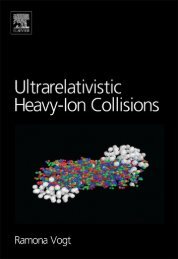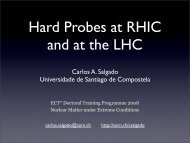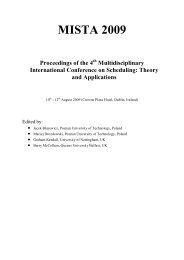Advances in perturbative thermal field theory - Ultra-relativistic ...
Advances in perturbative thermal field theory - Ultra-relativistic ...
Advances in perturbative thermal field theory - Ultra-relativistic ...
You also want an ePaper? Increase the reach of your titles
YUMPU automatically turns print PDFs into web optimized ePapers that Google loves.
Thermal <strong>field</strong> <strong>theory</strong> 357<br />
It is of course more convenient to stick to the rest frame of the heat bath. Lorentz <strong>in</strong>variance<br />
appears to be broken then, but it is usually a trivial matter to switch to Lorentz covariant<br />
expressions us<strong>in</strong>g u µ .<br />
Information about the dynamics of a <strong>thermal</strong> system can be obta<strong>in</strong>ed by consider<strong>in</strong>g<br />
<strong>thermal</strong> expectation values of the generally time-dependent observables (<strong>in</strong> the Heisenberg<br />
picture). In l<strong>in</strong>ear response <strong>theory</strong>, the time evolution of small disturbances of an equilibrium<br />
system is determ<strong>in</strong>ed by the correlation functions of pairs of observables [14].<br />
For both the purpose of calculat<strong>in</strong>g the partition function, Z, and correlation functions,<br />
there exist two equivalent but rather different look<strong>in</strong>g formalisms to set up perturbation <strong>theory</strong>.<br />
These correspond to the two most popular choices of a complex-time path <strong>in</strong> the path <strong>in</strong>tegral<br />
formula:<br />
∫<br />
∫ ∫<br />
〈T c ˆϕ 1 ··· ˆϕ n 〉=N Dϕϕ 1 ···ϕ n exp i dt d 3 xL, (2.12)<br />
C<br />
where T c denotes contour order<strong>in</strong>g along the complex-time path C from t 0 to t 0 − iβ such that<br />
t i ∈ C, and t 1 ≽ t 2 ≽ ··· ≽ t n with respect to a monotonically <strong>in</strong>creas<strong>in</strong>g contour parameter.<br />
L is the Lagrangian, which <strong>in</strong> the presence of a chemical potential µ ≠ 0 may be replaced<br />
by L → ¯L = L + µN , provided N does not conta<strong>in</strong> time derivatives. Analyticity requires<br />
that along the complex-time path the imag<strong>in</strong>ary part of t is monotonically decreas<strong>in</strong>g [11]; <strong>in</strong><br />
the limit<strong>in</strong>g case of a constant imag<strong>in</strong>ary part of t along (parts of) the contour, distributional<br />
quantities (generalized functions) arise.<br />
Perturbation <strong>theory</strong> is set up <strong>in</strong> the usual fashion. Us<strong>in</strong>g the <strong>in</strong>teraction-picture<br />
representation, one can derive<br />
〈T c O 1 ···O n 〉= Z 0<br />
Z 〈T cO 1 ···O n e i ∫ C L I<br />
〉 0 , (2.13)<br />
where L I is the <strong>in</strong>teraction part of L, and the correlators on the right-hand side can be evaluated<br />
by a Wick(–Bloch–DeDom<strong>in</strong>icis) theorem:<br />
〈T c e i ∫ C d4 xj ϕ 〉 0 = exp<br />
{<br />
− 1 2<br />
∫<br />
C<br />
∫<br />
C<br />
}<br />
d 4 x d 4 x ′ j(x)D c (x − x ′ )j (x ′ ) , (2.14)<br />
where D c is the two-po<strong>in</strong>t function and this is the only build<strong>in</strong>g block of Feynman graphs with<br />
an explicit T and µ dependence. It satisfies the Kubo–Mart<strong>in</strong>–Schw<strong>in</strong>ger (KMS) condition<br />
D c (t − iβ) =±e −µβ D c (t), (2.15)<br />
stat<strong>in</strong>g that e iµt D(t) is periodic (anti-periodic) for bosons (fermions).<br />
A KMS condition can be formulated for all correlation functions <strong>in</strong> <strong>thermal</strong> equilibrium and<br />
can <strong>in</strong> turn be viewed as a general criterion for equilibrium [15]. There exists also a <strong>relativistic</strong><br />
version of the KMS condition [16,17], which encodes the stronger analyticity requirements of<br />
<strong>relativistic</strong> quantum <strong>field</strong> theories. The <strong>relativistic</strong> spectrum condition, H |P|, where P is<br />
the total three-momentum, implies analyticity <strong>in</strong>volv<strong>in</strong>g all space–time variables x → z ∈ C 4<br />
<strong>in</strong> tube doma<strong>in</strong>s |Im z| < Im z 0







